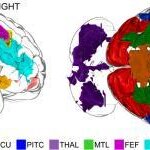Neuroscience

Experimenting with Babies: 50 Amazing Science Projects You Can Perform on Your Kid, out today, teaches parents how to recreate landmark scientific studies on cognitive, motor, social and behavioral development—using their own bundles of joy as the research subjects.
Here's one you can do with your own child, based on a 2012 study, to see how early children can learn about how competent an adult is:
Age Range: Between 15 and 18 months old
Research Area:Cognitive and social development
The Experiment:
For this experiment, you'll need two adults and about a dozen common objects whose names…

Instead of letting them mess around on the Wii or, worse, watching a "Baby Einstein" video, the way to make kids of all ages and incomes smarter could be as simple as handing them a few blocks.
Playing with blocks may help preschoolers develop the kinds of skills that support later learning in science, technology, engineering, and math (STEM), according to a new study.
More than a hundred 3-year-olds of various socioeconomic levels took part in the study. Children who were better at copying block structures were also better at early math, the study found. Among the skills tested were whether…
Previous research into genetic variants has shown that dancers really are different than most people and a new neuroscience study sheds some light on ballet brains as well.
Differences in the brain structure of ballet dancers may help them avoid feeling dizzy when they perform pirouettes - and that ability to suppress signals from the balance organs in the inner ear can happen as a result of training, which could help to improve treatment for patients with chronic dizziness.
Normally, the feeling of dizziness stems from the vestibular organs in the inner ear. These fluid-filled…

Why don't apes have musical talent?
Humans, parrots, small birds, elephants, whales, and bats do and Matz Larsson, senior physician at the Lung Clinic at Örebro University Hospital in Sweden, asserts that the ability to mimic and imitate things like music and speech is the result of the fact that synchronized group movement makes it possible to perceive sounds from the surroundings better.
There are numerous hypotheses about music and evolution, as the article in Animal Cognition notes: Darwin, Miller, Pinker and others have proposed that music evolved as a system to attract mates,…

A recently published paper strongly suggests men succumb to sexual temptations more than women — for example, cheating on a partner or stealing a girl from another guy — because they experience strong sexual impulses, not because they have weak self-control. At least when it comes to those of college age.
Previous papers have said that men are more likely than women to pursue romantic partners that are "off limits" but there has been no real theoretical explanation for this sex difference.
One possible explanation for this effect is that men experience stronger sexual impulses than women do.…

While you are reading this article, you could be getting a little smarter, but you could also be losing important information.
An idle brain is still doing important work and in the age of constant information overload, it’s a good idea to go offline on a regular basis, says Erik Fransén, a researcher from Stockholm's KTH Royal Institute of Technology.
Fransén's research focuses on short-term memory and ways to treat diseased neurons and he says that a brain exposed to a typical session of social media browsing can easily become hobbled by information overload. The result is that less…

Philosophers and scientists have long puzzled over where human imagination comes from - in other words, what makes humans able to create art, invent tools, think scientifically and perform other incredibly diverse behaviors?
The answer, according to a new study, lies in a widespread neural network -- the brain's "mental workspace" -- that consciously manipulates images, symbols, ideas and theories and gives humans the laser-like mental focus needed to solve complex problems and come up with new ideas. Scholars have hypothesized that human imagination requires a widespread neural network in…

The brain's structure may predict whether a person will suffer chronic lower back pain, according to researchers who used brain scans and say the results support the growing idea that the brain plays a critical role in chronic pain, a concept that may lead to changes in the way doctors treat patients.
Chronic pain affects up to an estimated 100 million Americans and could cost the United States hundreds of billions of dollars per year to treat. Lower back pain represents about 28 percent of all causes of pain in the United States; about 23 percent of these patients suffer chronic, or long-…

Anorexia nervosa is a multifactorial neuropsychiatric condition that affects as many as one percent of women in the Western world, and has an estimated mortality as high as 10 percent, making it perhaps the deadliest of mental illnesses. Anorexics severely restrict eating and become emaciated, yet consider themselves overweight. Individuals with anorexia tend to be perfectionistic, anxious or depressed, and obsessive.
The largest DNA-sequencing study of anorexia nervosa to-date has linked the eating disorder to variants in a gene coding for an enzyme that regulates cholesterol metabolism,…

The human brain is adept at linking seemingly random details into a cohesive memory that can trigger myriad associations — some good and some not so good.
For recovering addicts or individuals with post-traumatic stress disorder (PTSD), unwanted memories can make recovery difficult. For example, former meth addicts report intense drug cravings triggered by associations with cigarettes, money, even gum, which makes them more likely to stumble during recovery.
Scientists have been able to erase drug-associated memories in mice and rats without affecting other more benign memories. Their…